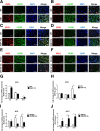Elevated Kallikrein-binding protein in diabetes impairs wound healing through inducing macrophage M1 polarization
- PMID: 31182110
- PMCID: PMC6558923
- DOI: 10.1186/s12964-019-0376-9
Elevated Kallikrein-binding protein in diabetes impairs wound healing through inducing macrophage M1 polarization
Abstract
Background: The accumulation of M1-polarized macrophages and excessive inflammation are important in the pathogenesis of diabetic foot ulcer (DFU). However, the underlying mechanism of DFU pathogenesis and the crucial regulators of DFU are less well known. Our previous study reported that kallikrein-binding protein (KBP), an angiogenesis inhibitor, was significantly upregulated in diabetic patients compared to its levels in controls. The effects of KBP on monocyte chemotaxis and macrophage M1 polarization were elucidated in this study.
Methods: Plasma KBP levels and monocyte counts were assessed by ELISA and flow cytometry. Wound closure rates in different groups were monitored daily. The phenotype and recruitment of macrophages were measured by real-time PCR, western blot and immunofluorescence assays. The expression of Notch and NF-κB signalling pathway members was determined by the methods mentioned above. ChIP and dual-luciferase reporter gene assays were employed to explore the binding and transcriptional regulation of Hes1 and iNOS.
Results: We found that plasma KBP levels and circulating monocytes were elevated in diabetic patients compared to those in nondiabetic controls, and both were higher in diabetic patients with DFU than in diabetic patients without DFU. KBP delayed wound healing in normal mice; correspondingly, KBP-neutralizing antibody ameliorated delayed wound healing in diabetic mice. Circulating monocytes and macrophage infiltration in the wound were upregulated in KBP-TG mice compared to those in control mice. KBP promoted the recruitment and M1 polarization of macrophages. Mechanistically, KBP upregulated iNOS by activating the Notch1/RBP-Jκ/Hes1 signalling pathway. Hes1 downregulated CYLD, a negative regulator of NF-κB signalling, and then activated the IKK/IκBα/NF-κB signalling pathway.
Conclusions: Our findings demonstrate that KBP is the key regulator of excessive inflammation in DFUs and provide a novel target for DFU therapy.
Keywords: Diabetic wound healing; Kallikrein-binding protein; Monocyte-macrophages; Notch/NF-κB signalling.
Conflict of interest statement
The authors declare that they have no competing interests.
Figures








References
Publication types
MeSH terms
Substances
LinkOut - more resources
Full Text Sources
Medical
Miscellaneous

